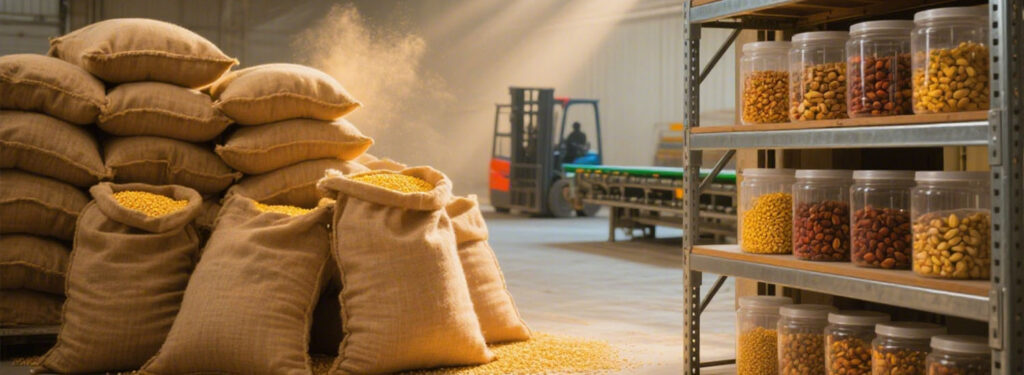
Long-Term Indoor Humidity Control: Ensuring the Safety of Grain and Nut Storage
Do you know that every year, grain storage losses can reach up to 15%?
This is primarily because of moisture-related issues like spoilage and mold. That’s why it’s important to have a long-term indoor humidity control solution to keep the grains and nuts at the right temperature and save them from mold, pests, and spoilage.
If you’re a small-scale seller, a bulk buyer, or a facility manager, you need to understand that the science of moisture protection can save you thousands in losses.
Let’s break it down for you in easy terms, starting from common issues.
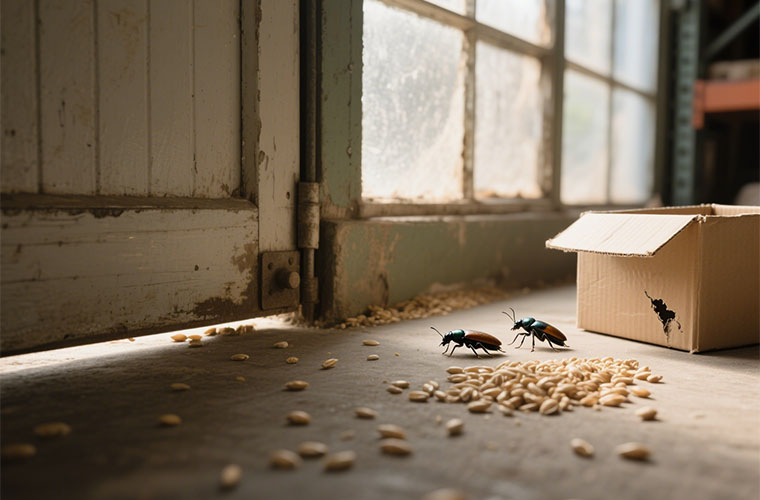
Key Takeaways
- Common Issues: Small mistakes in humidity or temperature can cause mold, pests, or spoilage. As soon as these problems start, they spread fast and can be damaging.
- Drawbacks: Large, poorly sealed, or humid spaces make climate control almost impossible. These conditions create hot spots for mold, pests, and moisture damage.
- Best Solution: The most reliable way to protect stock is to keep humidity stable. Dehumidifiers make it easy to prevent mold, reduce pests, and extend shelf life.
Coairo’s Dehumidifiers: Coairo’s dehumidifiers offer stable long-term indoor humidity control at low running costs. They are trusted by professionals in preventing storage problems.
Three Common Issues in Storing Grain and Nuts
Storing grain and nuts may seem simple, but even small mistakes in temperature or humidity can lead to serious problems. These problems reduce the quality of your stock and make it unsafe for consumption.
1. Mold Growth
Mold begins to grow when moisture levels in grains and nuts rise above the safe limits. For grains, this is usually around 10-14% moisture content. However, for nuts it’s generally between 6 to 8%, but may vary for kernels that go up to 12%.
If your storage space has high moisture, it means there’s more humidity. And this humidity is the perfect breeding ground for mold spores. When it starts forming, it spreads like a fire and causes visible spots, musty odors, and nutrient loss.
2. Pest Infestation
Another problem storage spaces face is pests. They are a silent but destructive force in grain and nut storage. Warm, slightly damp, or poorly sealed storage space is ideal for insects like weevils, moths, and beetles.
They can enter through small cracks or even with the product itself during harvest. Once inside, they reproduce rapidly, feeding on and hollowing out grains or damaging nuts from within.
3. Risk of Spoilage
Spoilage is often the result of poor overall storage conditions. High temperatures, fluctuating humidity, or a lack of ventilation can speed up natural deterioration.
Nuts are especially sensitive because their oils can turn rancid and create an unpleasant smell. Grains, on the other hand, can lose germ viability and nutritional value when exposed to heat for too long.
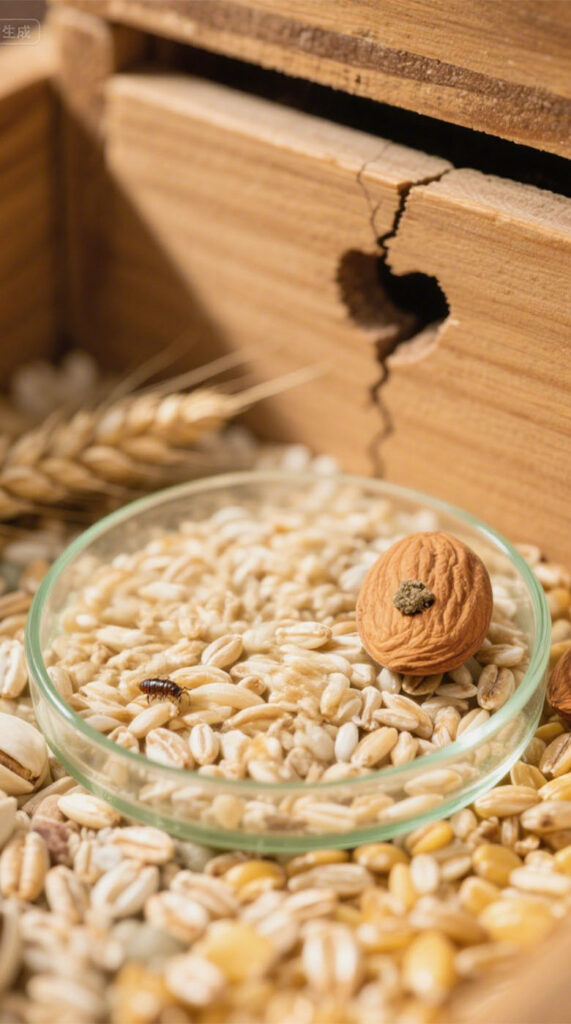
Drawbacks of Storing Grain and Nuts in Warehouses or Storage Rooms
At first, large spaces and simple storage often look convenient to store grain and nuts. But they bring real risks to quality and profit. Below are the main problems, why they happen, and what they cost you.
1. Large Space: Harder to Keep Conditions Even
Big rooms sound useful, but they make climate control difficult. Corners and high shelves can trap warm, moist air while other areas stay dry. That unevenness creates “hot spots” where spoilage or mold starts first.
You’d be surprised to know that around 14% of global food production is lost after harvest only because they were not handled or stored correctly.
2. Poor Sealing: Air and Pests Get In
Having sacks, loose crates, and poorly sealed doors in your storage area lets humidity flow through your crop. That brings in insects, rodents, and dust. When pests find their way in, they settle quickly and multiply rapidly.
For most commodities, this contamination and mycotoxin damage means huge losses, even hundreds of millions of tons.
3. High Humidity: Mold and Rancidity Accelerate
There’s nothing more dangerous than moisture for grains and nuts every single year. It’s because different types of grains and nuts have different humidity levels.
For example, you must keep almonds cool and under 65% relative humidity. If you keep them or any other crops above the safe moisture levels, mold will develop and ruin the harvest within days.
4. Temperature Swings: Condensation and Hidden Damp Spots
Heat and cold swings cause condensation inside bags and on wooden shelves. That water then soaks into the product. You won’t see this moisture on the surface right away.
But it creates ideal conditions for mold and insect breeding. Over time, this unseen dampness destroys the shelf life and value of your harvest.
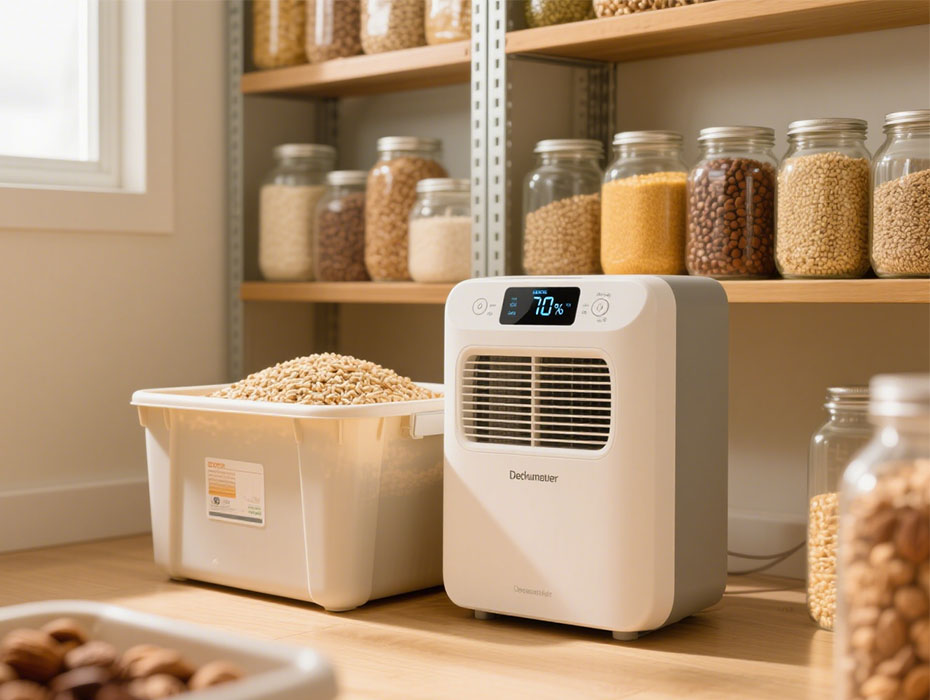
Best Solution? Long-Term Indoor Humidity Control
If you want to keep the grain and nuts safe for months, it comes down to one thing: maintaining long-term indoor humidity control. The best way to do so is by using a dehumidifier from a brand that you can trust.
Experts recommend keeping grain temperature between 18 and 23 degrees Celsius in summer and less than 15 degrees Celsius in winter.
A dehumidifier makes this easier by removing excess moisture from the air and keeping humidity at safe levels year-round. This is critical because when humidity exceeds 70%, the risk of mold growth and spoilage rises sharply.
To save you from searching for ideal moisture content for different grains and nuts, here’s a handy reference table:
Crop | EMC (Equilibrium Moisture Content) | Relative Humidity (RH) |
Maize Shelled | 13.5% | ~ 60 to 65% |
Maize Flour | 11.5% | ~ 50 to 55% |
Wheat | 13.5% | ~ 65% |
Wheat Flour | 12.0% | ~ 55 to 60% |
Sorghum | 13.5% | ~ 60 to 65% |
Millet | 16.0% | ~ 75% |
Paddy | 15.0% | ~ 70% |
Rice | 13.0% | ~ 60 to 65% |
Pulses | 15.0% | ~ 70% |
Lentil, Pea | 14.0% | ~ 65 to 70% |
Groundnut (Shelled) | 7.0% | ~ 30 to 40% |
Keep Your Stored Crops Safe with Coairo
Even though we’ve seen how long-term indoor humidity control can be the perfect solution, choosing the right one can be a headache.
This is where Coairo comes in to clear the air, literally.
It keeps humidity stable all year, costs less to run compared to many competitors, and delivers proven results in reducing mold risk. Farmers, warehouse owners, and food processors trust Coairo because it’s simple, affordable, and highly effective.
Check out Coairo’s dehumidifiers today and stop worrying about your storage conditions!
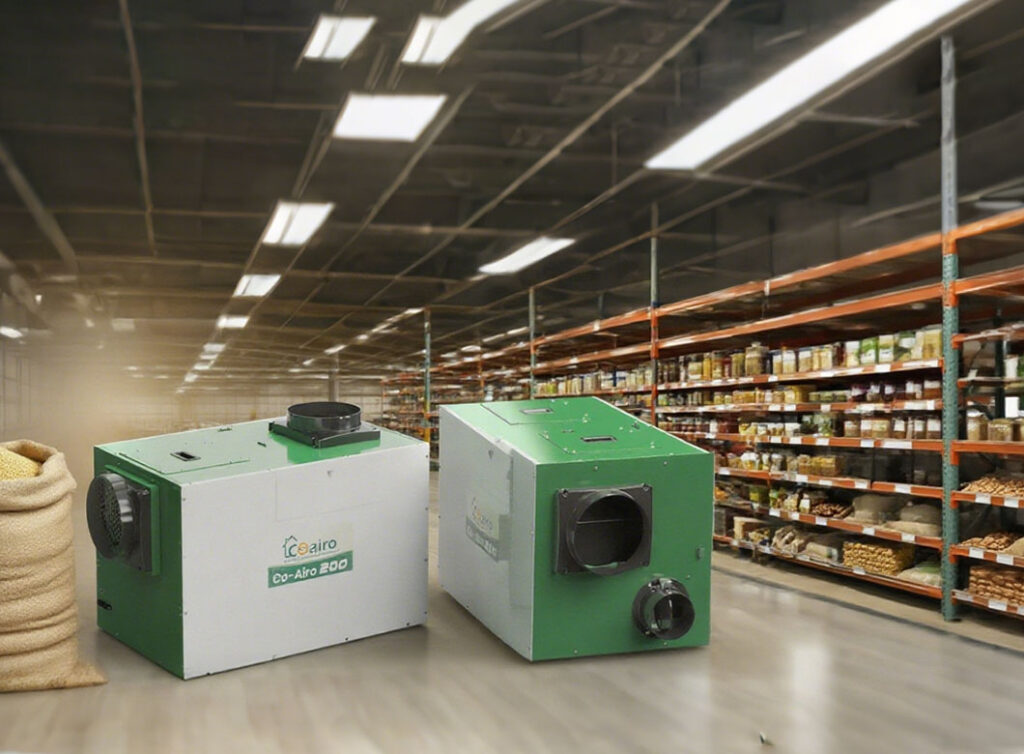
FAQs
1. Can pests be reduced by controlling humidity?
Yes. Many storage pests, including weevils and moths, thrive in warm and humid environments. When humidity drops below their survival range, their reproduction slows dramatically or stops altogether.
2. What’s the ideal humidity level for storing grains and nuts?
For most grains, humidity should be kept around 50–60% to maintain moisture content at safe levels (about 13–14%). For nuts, a lower humidity of around 40–50% is best, keeping their moisture at 8–10%.